Analysis of Renewable Energy Management and Authority in Country X
VerifiedAdded on 2023/01/19
|11
|2517
|70
Report
AI Summary
This report delves into the critical need for establishing a Renewable Energy Authority in Country X, a developing nation grappling with energy security challenges. It explores the current energy patterns, highlighting the environmental unsustainability of fossil fuels and the disparity in energy access. The report emphasizes the importance of renewable energy sources like PV, wind, and CSP in meeting future energy demands and mitigating risks associated with conventional energy supplies. It analyzes various renewable energy policies and their effectiveness, drawing on case studies from countries like the UK, and others, to illustrate successful management strategies. The report underscores the role of government agencies in promoting renewable energy investments through financial incentives, policy instruments, and regulatory frameworks. Furthermore, it provides statistical data and projections related to renewable energy generation and demand, concluding with the potential of renewable energy to address the energy crisis in developing countries and the role of the Renewable Energy Authority in driving sustainable energy development. The report also discusses financing techniques and the adaptability of policies to changing market conditions.
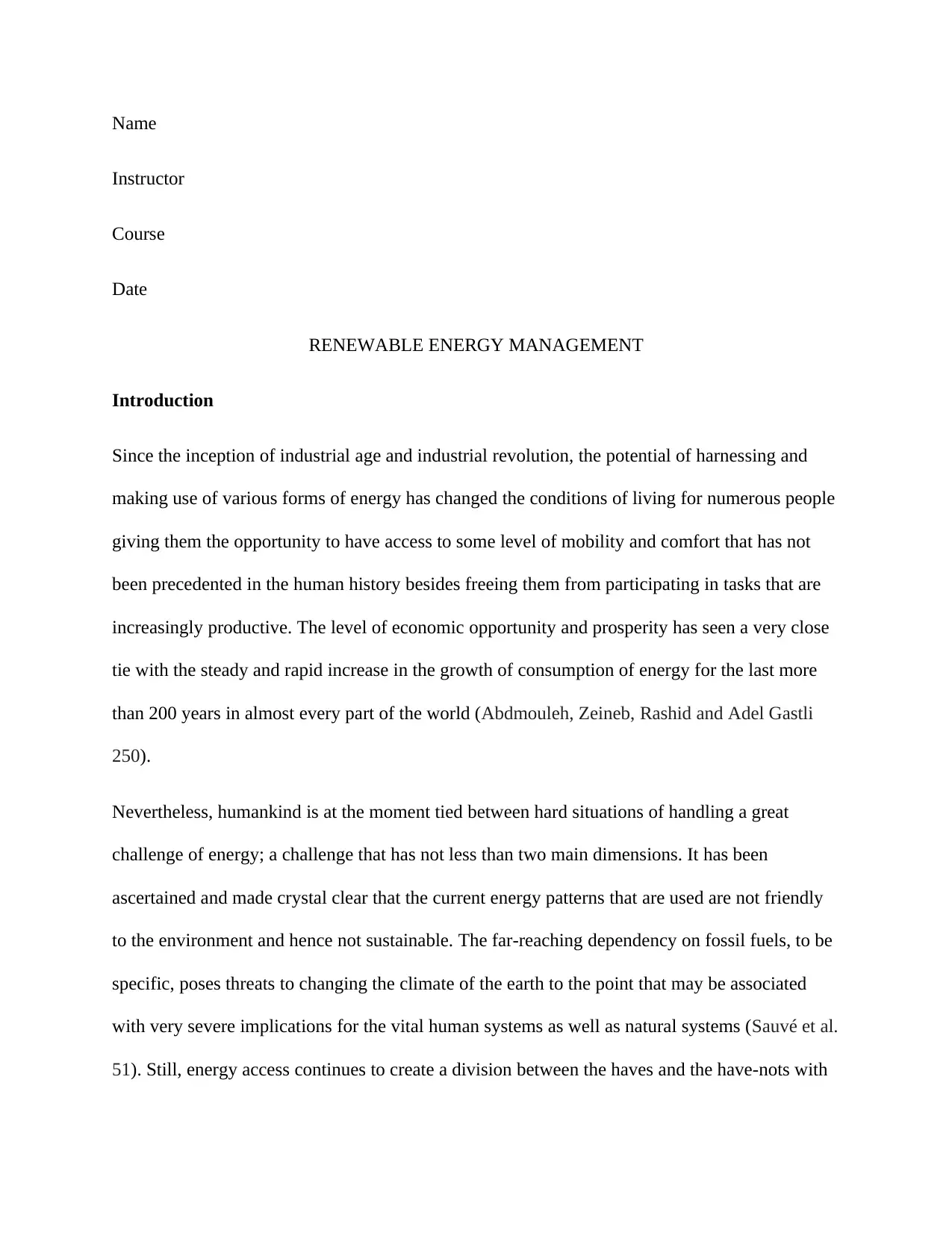
Name
Instructor
Course
Date
RENEWABLE ENERGY MANAGEMENT
Introduction
Since the inception of industrial age and industrial revolution, the potential of harnessing and
making use of various forms of energy has changed the conditions of living for numerous people
giving them the opportunity to have access to some level of mobility and comfort that has not
been precedented in the human history besides freeing them from participating in tasks that are
increasingly productive. The level of economic opportunity and prosperity has seen a very close
tie with the steady and rapid increase in the growth of consumption of energy for the last more
than 200 years in almost every part of the world (Abdmouleh, Zeineb, Rashid and Adel Gastli
250).
Nevertheless, humankind is at the moment tied between hard situations of handling a great
challenge of energy; a challenge that has not less than two main dimensions. It has been
ascertained and made crystal clear that the current energy patterns that are used are not friendly
to the environment and hence not sustainable. The far-reaching dependency on fossil fuels, to be
specific, poses threats to changing the climate of the earth to the point that may be associated
with very severe implications for the vital human systems as well as natural systems (Sauvé et al.
51). Still, energy access continues to create a division between the haves and the have-nots with
Instructor
Course
Date
RENEWABLE ENERGY MANAGEMENT
Introduction
Since the inception of industrial age and industrial revolution, the potential of harnessing and
making use of various forms of energy has changed the conditions of living for numerous people
giving them the opportunity to have access to some level of mobility and comfort that has not
been precedented in the human history besides freeing them from participating in tasks that are
increasingly productive. The level of economic opportunity and prosperity has seen a very close
tie with the steady and rapid increase in the growth of consumption of energy for the last more
than 200 years in almost every part of the world (Abdmouleh, Zeineb, Rashid and Adel Gastli
250).
Nevertheless, humankind is at the moment tied between hard situations of handling a great
challenge of energy; a challenge that has not less than two main dimensions. It has been
ascertained and made crystal clear that the current energy patterns that are used are not friendly
to the environment and hence not sustainable. The far-reaching dependency on fossil fuels, to be
specific, poses threats to changing the climate of the earth to the point that may be associated
with very severe implications for the vital human systems as well as natural systems (Sauvé et al.
51). Still, energy access continues to create a division between the haves and the have-nots with
Paraphrase This Document
Need a fresh take? Get an instant paraphrase of this document with our AI Paraphraser
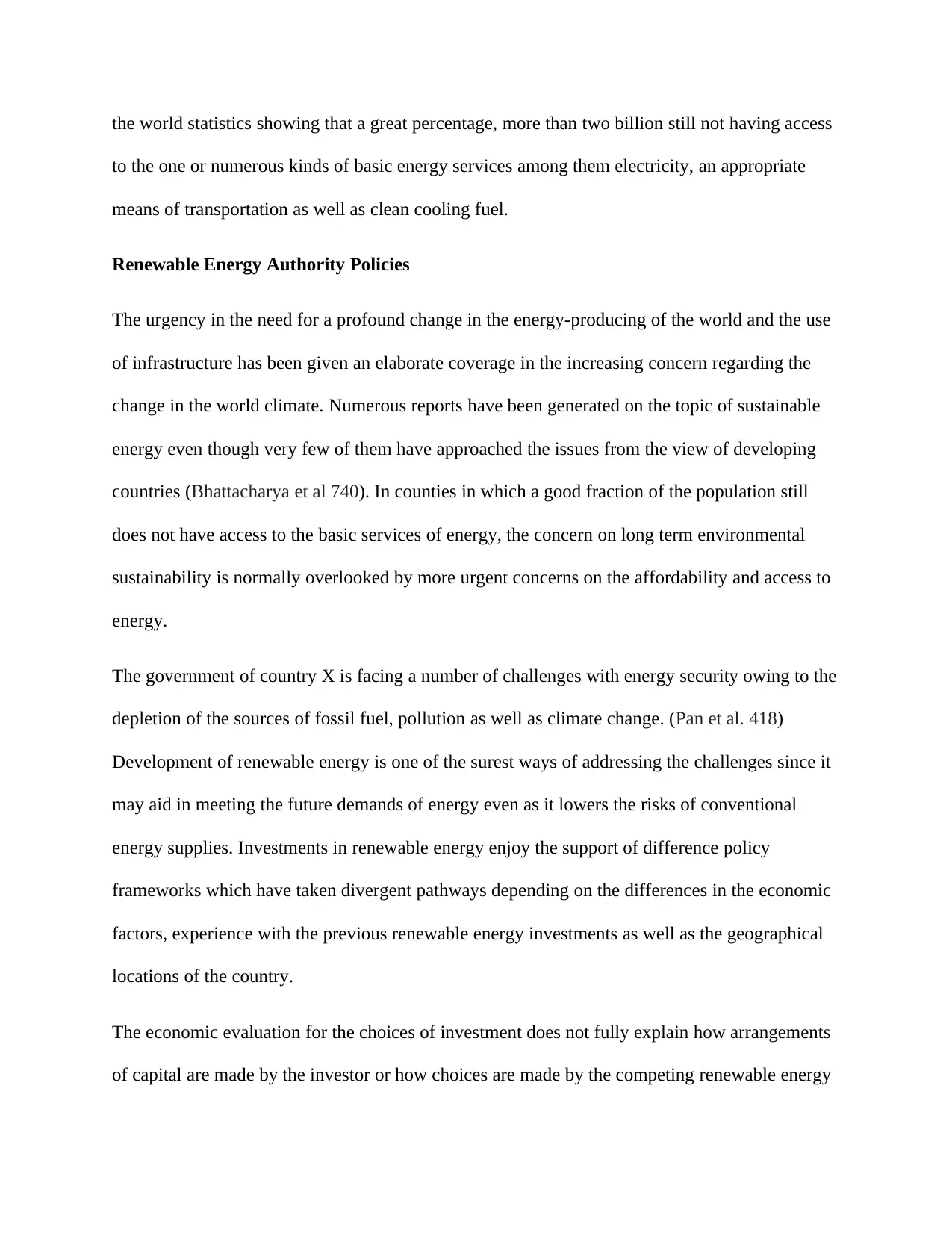
the world statistics showing that a great percentage, more than two billion still not having access
to the one or numerous kinds of basic energy services among them electricity, an appropriate
means of transportation as well as clean cooling fuel.
Renewable Energy Authority Policies
The urgency in the need for a profound change in the energy-producing of the world and the use
of infrastructure has been given an elaborate coverage in the increasing concern regarding the
change in the world climate. Numerous reports have been generated on the topic of sustainable
energy even though very few of them have approached the issues from the view of developing
countries (Bhattacharya et al 740). In counties in which a good fraction of the population still
does not have access to the basic services of energy, the concern on long term environmental
sustainability is normally overlooked by more urgent concerns on the affordability and access to
energy.
The government of country X is facing a number of challenges with energy security owing to the
depletion of the sources of fossil fuel, pollution as well as climate change. (Pan et al. 418)
Development of renewable energy is one of the surest ways of addressing the challenges since it
may aid in meeting the future demands of energy even as it lowers the risks of conventional
energy supplies. Investments in renewable energy enjoy the support of difference policy
frameworks which have taken divergent pathways depending on the differences in the economic
factors, experience with the previous renewable energy investments as well as the geographical
locations of the country.
The economic evaluation for the choices of investment does not fully explain how arrangements
of capital are made by the investor or how choices are made by the competing renewable energy
to the one or numerous kinds of basic energy services among them electricity, an appropriate
means of transportation as well as clean cooling fuel.
Renewable Energy Authority Policies
The urgency in the need for a profound change in the energy-producing of the world and the use
of infrastructure has been given an elaborate coverage in the increasing concern regarding the
change in the world climate. Numerous reports have been generated on the topic of sustainable
energy even though very few of them have approached the issues from the view of developing
countries (Bhattacharya et al 740). In counties in which a good fraction of the population still
does not have access to the basic services of energy, the concern on long term environmental
sustainability is normally overlooked by more urgent concerns on the affordability and access to
energy.
The government of country X is facing a number of challenges with energy security owing to the
depletion of the sources of fossil fuel, pollution as well as climate change. (Pan et al. 418)
Development of renewable energy is one of the surest ways of addressing the challenges since it
may aid in meeting the future demands of energy even as it lowers the risks of conventional
energy supplies. Investments in renewable energy enjoy the support of difference policy
frameworks which have taken divergent pathways depending on the differences in the economic
factors, experience with the previous renewable energy investments as well as the geographical
locations of the country.
The economic evaluation for the choices of investment does not fully explain how arrangements
of capital are made by the investor or how choices are made by the competing renewable energy
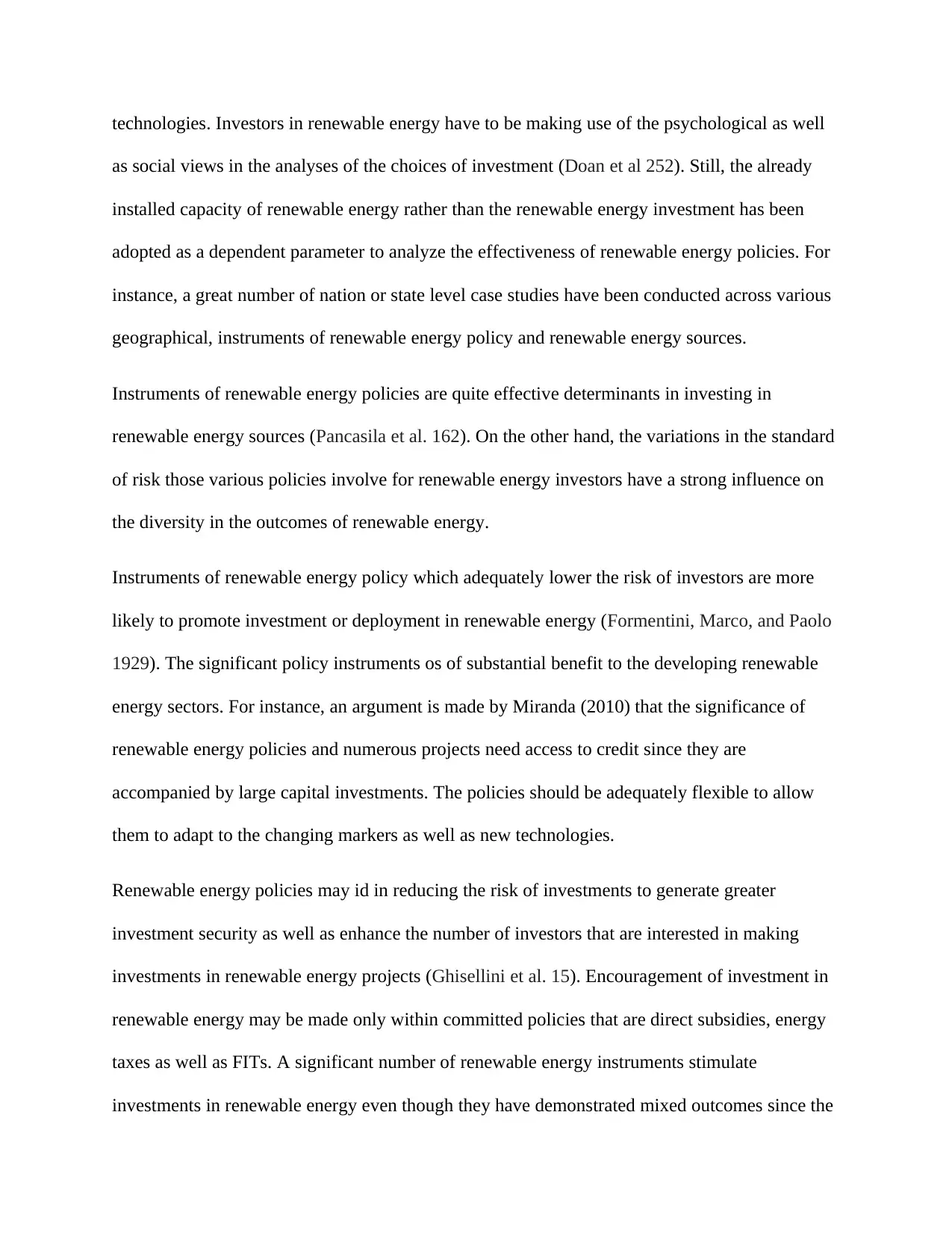
technologies. Investors in renewable energy have to be making use of the psychological as well
as social views in the analyses of the choices of investment (Doan et al 252). Still, the already
installed capacity of renewable energy rather than the renewable energy investment has been
adopted as a dependent parameter to analyze the effectiveness of renewable energy policies. For
instance, a great number of nation or state level case studies have been conducted across various
geographical, instruments of renewable energy policy and renewable energy sources.
Instruments of renewable energy policies are quite effective determinants in investing in
renewable energy sources (Pancasila et al. 162). On the other hand, the variations in the standard
of risk those various policies involve for renewable energy investors have a strong influence on
the diversity in the outcomes of renewable energy.
Instruments of renewable energy policy which adequately lower the risk of investors are more
likely to promote investment or deployment in renewable energy (Formentini, Marco, and Paolo
1929). The significant policy instruments os of substantial benefit to the developing renewable
energy sectors. For instance, an argument is made by Miranda (2010) that the significance of
renewable energy policies and numerous projects need access to credit since they are
accompanied by large capital investments. The policies should be adequately flexible to allow
them to adapt to the changing markers as well as new technologies.
Renewable energy policies may id in reducing the risk of investments to generate greater
investment security as well as enhance the number of investors that are interested in making
investments in renewable energy projects (Ghisellini et al. 15). Encouragement of investment in
renewable energy may be made only within committed policies that are direct subsidies, energy
taxes as well as FITs. A significant number of renewable energy instruments stimulate
investments in renewable energy even though they have demonstrated mixed outcomes since the
as social views in the analyses of the choices of investment (Doan et al 252). Still, the already
installed capacity of renewable energy rather than the renewable energy investment has been
adopted as a dependent parameter to analyze the effectiveness of renewable energy policies. For
instance, a great number of nation or state level case studies have been conducted across various
geographical, instruments of renewable energy policy and renewable energy sources.
Instruments of renewable energy policies are quite effective determinants in investing in
renewable energy sources (Pancasila et al. 162). On the other hand, the variations in the standard
of risk those various policies involve for renewable energy investors have a strong influence on
the diversity in the outcomes of renewable energy.
Instruments of renewable energy policy which adequately lower the risk of investors are more
likely to promote investment or deployment in renewable energy (Formentini, Marco, and Paolo
1929). The significant policy instruments os of substantial benefit to the developing renewable
energy sectors. For instance, an argument is made by Miranda (2010) that the significance of
renewable energy policies and numerous projects need access to credit since they are
accompanied by large capital investments. The policies should be adequately flexible to allow
them to adapt to the changing markers as well as new technologies.
Renewable energy policies may id in reducing the risk of investments to generate greater
investment security as well as enhance the number of investors that are interested in making
investments in renewable energy projects (Ghisellini et al. 15). Encouragement of investment in
renewable energy may be made only within committed policies that are direct subsidies, energy
taxes as well as FITs. A significant number of renewable energy instruments stimulate
investments in renewable energy even though they have demonstrated mixed outcomes since the
⊘ This is a preview!⊘
Do you want full access?
Subscribe today to unlock all pages.

Trusted by 1+ million students worldwide
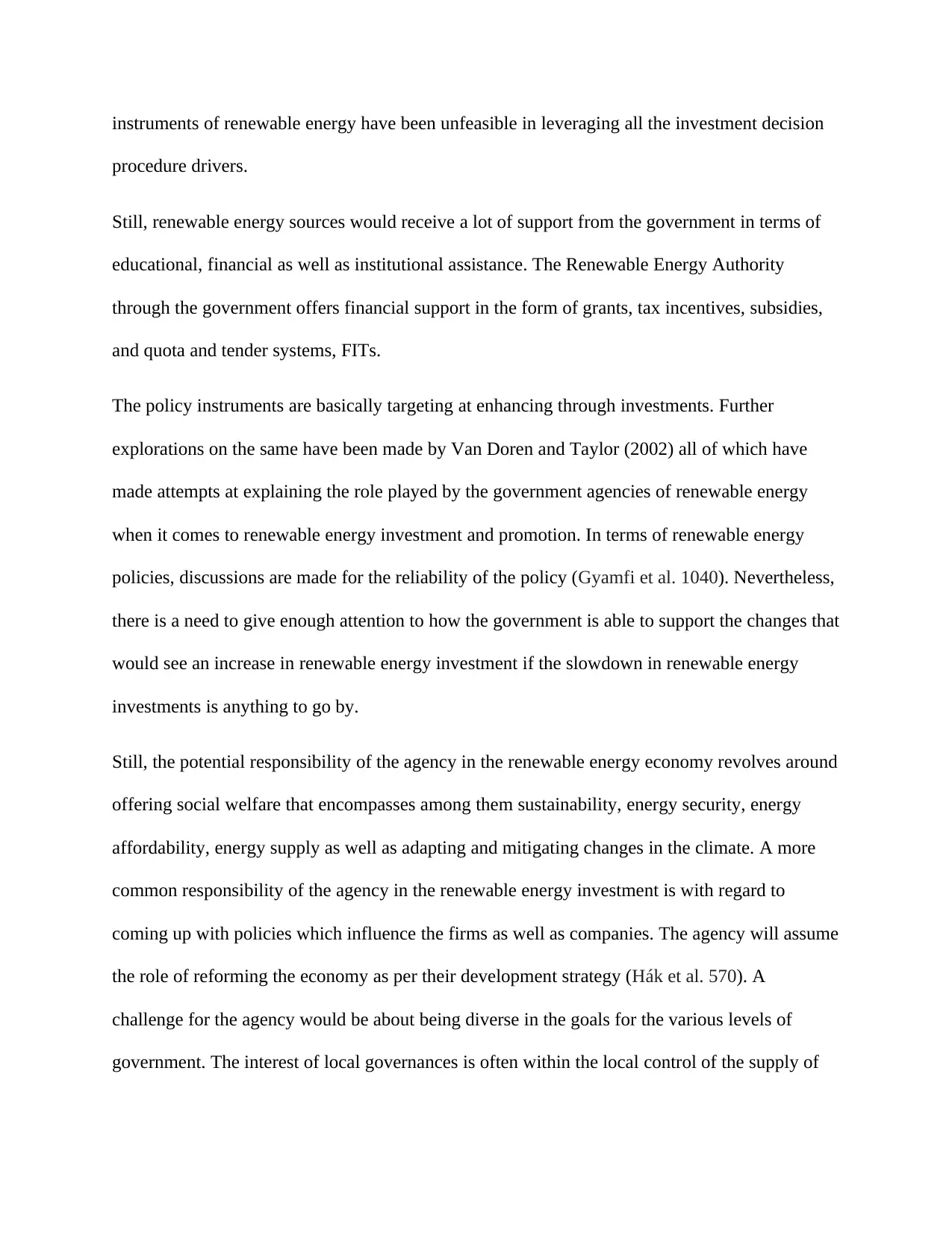
instruments of renewable energy have been unfeasible in leveraging all the investment decision
procedure drivers.
Still, renewable energy sources would receive a lot of support from the government in terms of
educational, financial as well as institutional assistance. The Renewable Energy Authority
through the government offers financial support in the form of grants, tax incentives, subsidies,
and quota and tender systems, FITs.
The policy instruments are basically targeting at enhancing through investments. Further
explorations on the same have been made by Van Doren and Taylor (2002) all of which have
made attempts at explaining the role played by the government agencies of renewable energy
when it comes to renewable energy investment and promotion. In terms of renewable energy
policies, discussions are made for the reliability of the policy (Gyamfi et al. 1040). Nevertheless,
there is a need to give enough attention to how the government is able to support the changes that
would see an increase in renewable energy investment if the slowdown in renewable energy
investments is anything to go by.
Still, the potential responsibility of the agency in the renewable energy economy revolves around
offering social welfare that encompasses among them sustainability, energy security, energy
affordability, energy supply as well as adapting and mitigating changes in the climate. A more
common responsibility of the agency in the renewable energy investment is with regard to
coming up with policies which influence the firms as well as companies. The agency will assume
the role of reforming the economy as per their development strategy (Hák et al. 570). A
challenge for the agency would be about being diverse in the goals for the various levels of
government. The interest of local governances is often within the local control of the supply of
procedure drivers.
Still, renewable energy sources would receive a lot of support from the government in terms of
educational, financial as well as institutional assistance. The Renewable Energy Authority
through the government offers financial support in the form of grants, tax incentives, subsidies,
and quota and tender systems, FITs.
The policy instruments are basically targeting at enhancing through investments. Further
explorations on the same have been made by Van Doren and Taylor (2002) all of which have
made attempts at explaining the role played by the government agencies of renewable energy
when it comes to renewable energy investment and promotion. In terms of renewable energy
policies, discussions are made for the reliability of the policy (Gyamfi et al. 1040). Nevertheless,
there is a need to give enough attention to how the government is able to support the changes that
would see an increase in renewable energy investment if the slowdown in renewable energy
investments is anything to go by.
Still, the potential responsibility of the agency in the renewable energy economy revolves around
offering social welfare that encompasses among them sustainability, energy security, energy
affordability, energy supply as well as adapting and mitigating changes in the climate. A more
common responsibility of the agency in the renewable energy investment is with regard to
coming up with policies which influence the firms as well as companies. The agency will assume
the role of reforming the economy as per their development strategy (Hák et al. 570). A
challenge for the agency would be about being diverse in the goals for the various levels of
government. The interest of local governances is often within the local control of the supply of
Paraphrase This Document
Need a fresh take? Get an instant paraphrase of this document with our AI Paraphraser
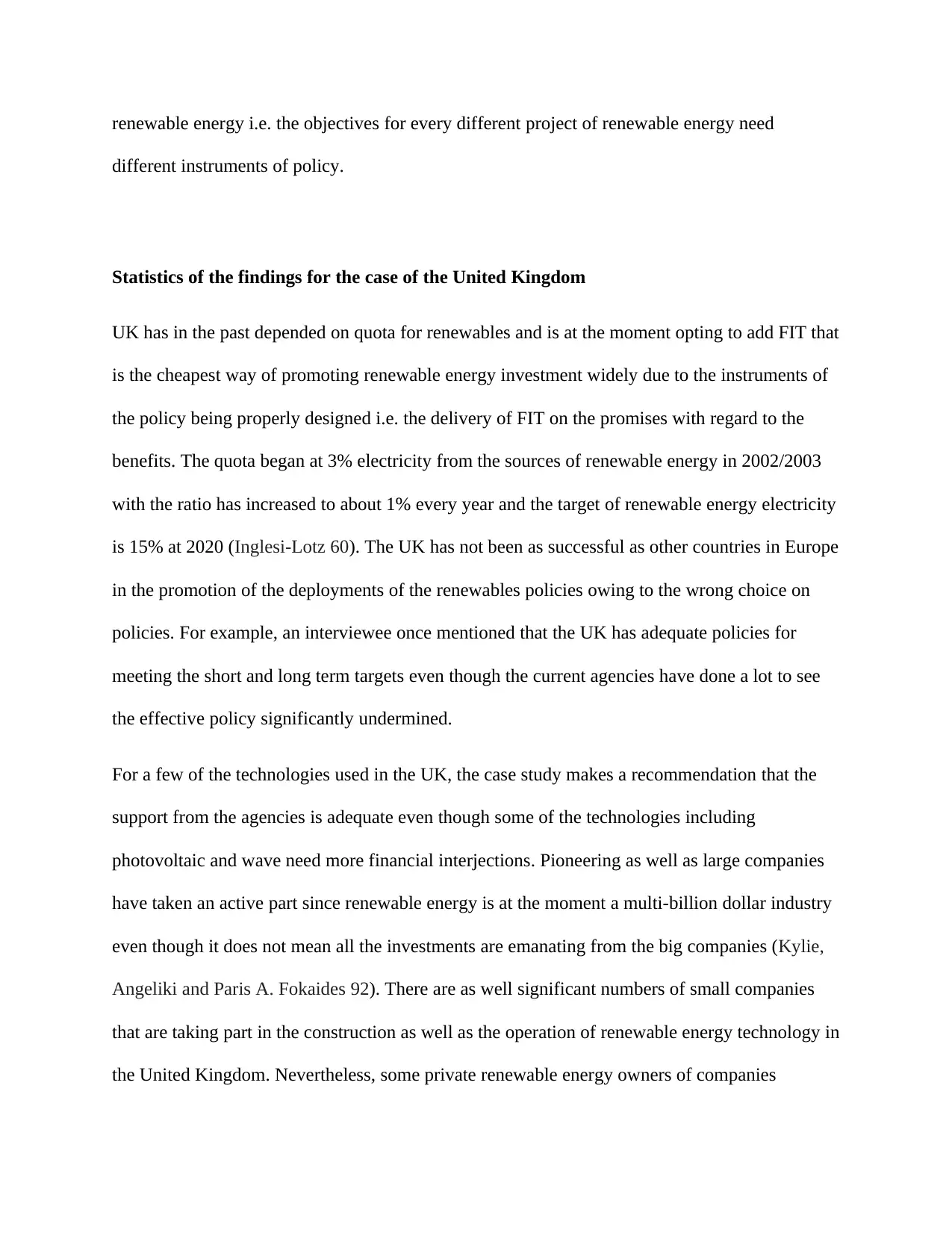
renewable energy i.e. the objectives for every different project of renewable energy need
different instruments of policy.
Statistics of the findings for the case of the United Kingdom
UK has in the past depended on quota for renewables and is at the moment opting to add FIT that
is the cheapest way of promoting renewable energy investment widely due to the instruments of
the policy being properly designed i.e. the delivery of FIT on the promises with regard to the
benefits. The quota began at 3% electricity from the sources of renewable energy in 2002/2003
with the ratio has increased to about 1% every year and the target of renewable energy electricity
is 15% at 2020 (Inglesi-Lotz 60). The UK has not been as successful as other countries in Europe
in the promotion of the deployments of the renewables policies owing to the wrong choice on
policies. For example, an interviewee once mentioned that the UK has adequate policies for
meeting the short and long term targets even though the current agencies have done a lot to see
the effective policy significantly undermined.
For a few of the technologies used in the UK, the case study makes a recommendation that the
support from the agencies is adequate even though some of the technologies including
photovoltaic and wave need more financial interjections. Pioneering as well as large companies
have taken an active part since renewable energy is at the moment a multi-billion dollar industry
even though it does not mean all the investments are emanating from the big companies (Kylie,
Angeliki and Paris A. Fokaides 92). There are as well significant numbers of small companies
that are taking part in the construction as well as the operation of renewable energy technology in
the United Kingdom. Nevertheless, some private renewable energy owners of companies
different instruments of policy.
Statistics of the findings for the case of the United Kingdom
UK has in the past depended on quota for renewables and is at the moment opting to add FIT that
is the cheapest way of promoting renewable energy investment widely due to the instruments of
the policy being properly designed i.e. the delivery of FIT on the promises with regard to the
benefits. The quota began at 3% electricity from the sources of renewable energy in 2002/2003
with the ratio has increased to about 1% every year and the target of renewable energy electricity
is 15% at 2020 (Inglesi-Lotz 60). The UK has not been as successful as other countries in Europe
in the promotion of the deployments of the renewables policies owing to the wrong choice on
policies. For example, an interviewee once mentioned that the UK has adequate policies for
meeting the short and long term targets even though the current agencies have done a lot to see
the effective policy significantly undermined.
For a few of the technologies used in the UK, the case study makes a recommendation that the
support from the agencies is adequate even though some of the technologies including
photovoltaic and wave need more financial interjections. Pioneering as well as large companies
have taken an active part since renewable energy is at the moment a multi-billion dollar industry
even though it does not mean all the investments are emanating from the big companies (Kylie,
Angeliki and Paris A. Fokaides 92). There are as well significant numbers of small companies
that are taking part in the construction as well as the operation of renewable energy technology in
the United Kingdom. Nevertheless, some private renewable energy owners of companies
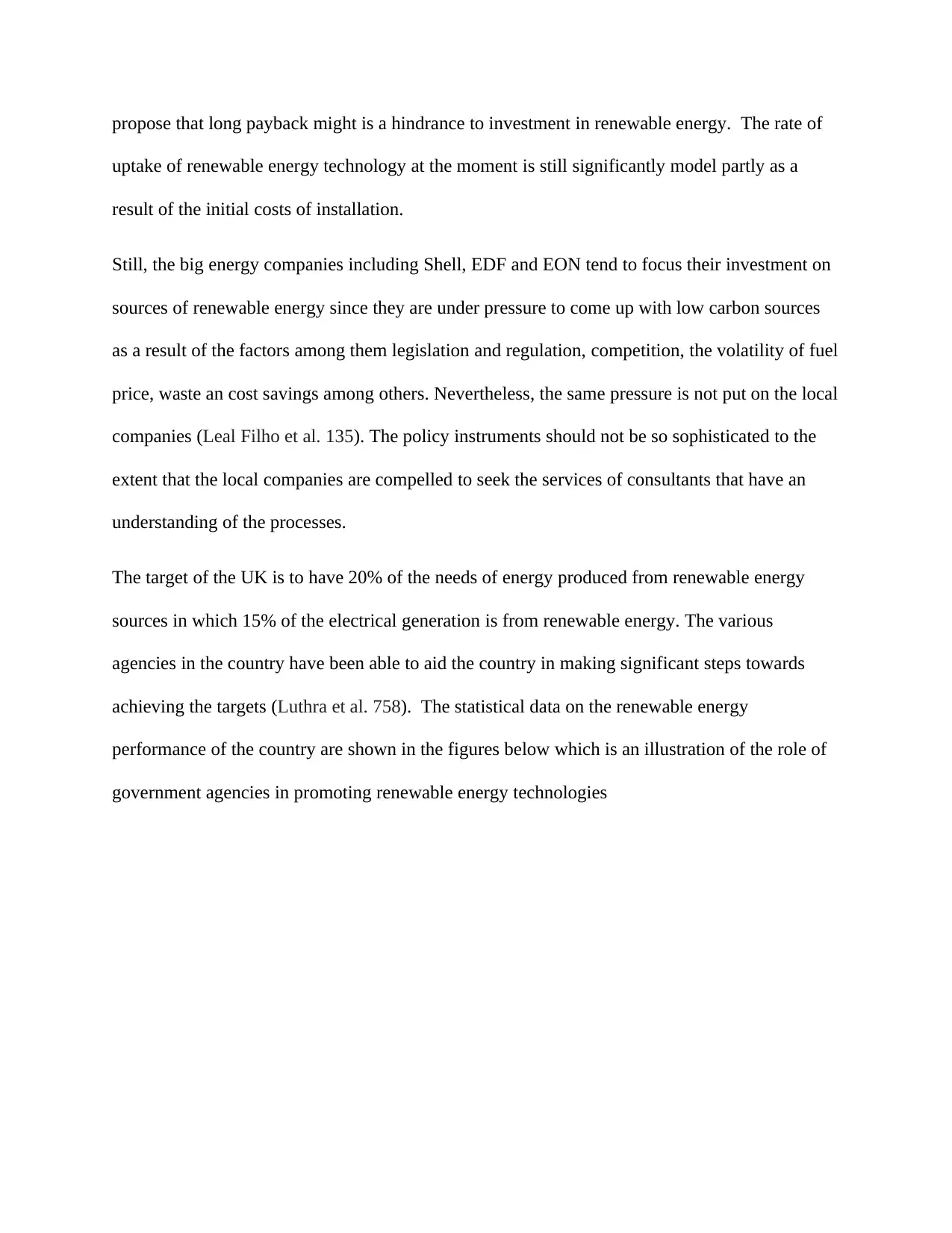
propose that long payback might is a hindrance to investment in renewable energy. The rate of
uptake of renewable energy technology at the moment is still significantly model partly as a
result of the initial costs of installation.
Still, the big energy companies including Shell, EDF and EON tend to focus their investment on
sources of renewable energy since they are under pressure to come up with low carbon sources
as a result of the factors among them legislation and regulation, competition, the volatility of fuel
price, waste an cost savings among others. Nevertheless, the same pressure is not put on the local
companies (Leal Filho et al. 135). The policy instruments should not be so sophisticated to the
extent that the local companies are compelled to seek the services of consultants that have an
understanding of the processes.
The target of the UK is to have 20% of the needs of energy produced from renewable energy
sources in which 15% of the electrical generation is from renewable energy. The various
agencies in the country have been able to aid the country in making significant steps towards
achieving the targets (Luthra et al. 758). The statistical data on the renewable energy
performance of the country are shown in the figures below which is an illustration of the role of
government agencies in promoting renewable energy technologies
uptake of renewable energy technology at the moment is still significantly model partly as a
result of the initial costs of installation.
Still, the big energy companies including Shell, EDF and EON tend to focus their investment on
sources of renewable energy since they are under pressure to come up with low carbon sources
as a result of the factors among them legislation and regulation, competition, the volatility of fuel
price, waste an cost savings among others. Nevertheless, the same pressure is not put on the local
companies (Leal Filho et al. 135). The policy instruments should not be so sophisticated to the
extent that the local companies are compelled to seek the services of consultants that have an
understanding of the processes.
The target of the UK is to have 20% of the needs of energy produced from renewable energy
sources in which 15% of the electrical generation is from renewable energy. The various
agencies in the country have been able to aid the country in making significant steps towards
achieving the targets (Luthra et al. 758). The statistical data on the renewable energy
performance of the country are shown in the figures below which is an illustration of the role of
government agencies in promoting renewable energy technologies
⊘ This is a preview!⊘
Do you want full access?
Subscribe today to unlock all pages.

Trusted by 1+ million students worldwide
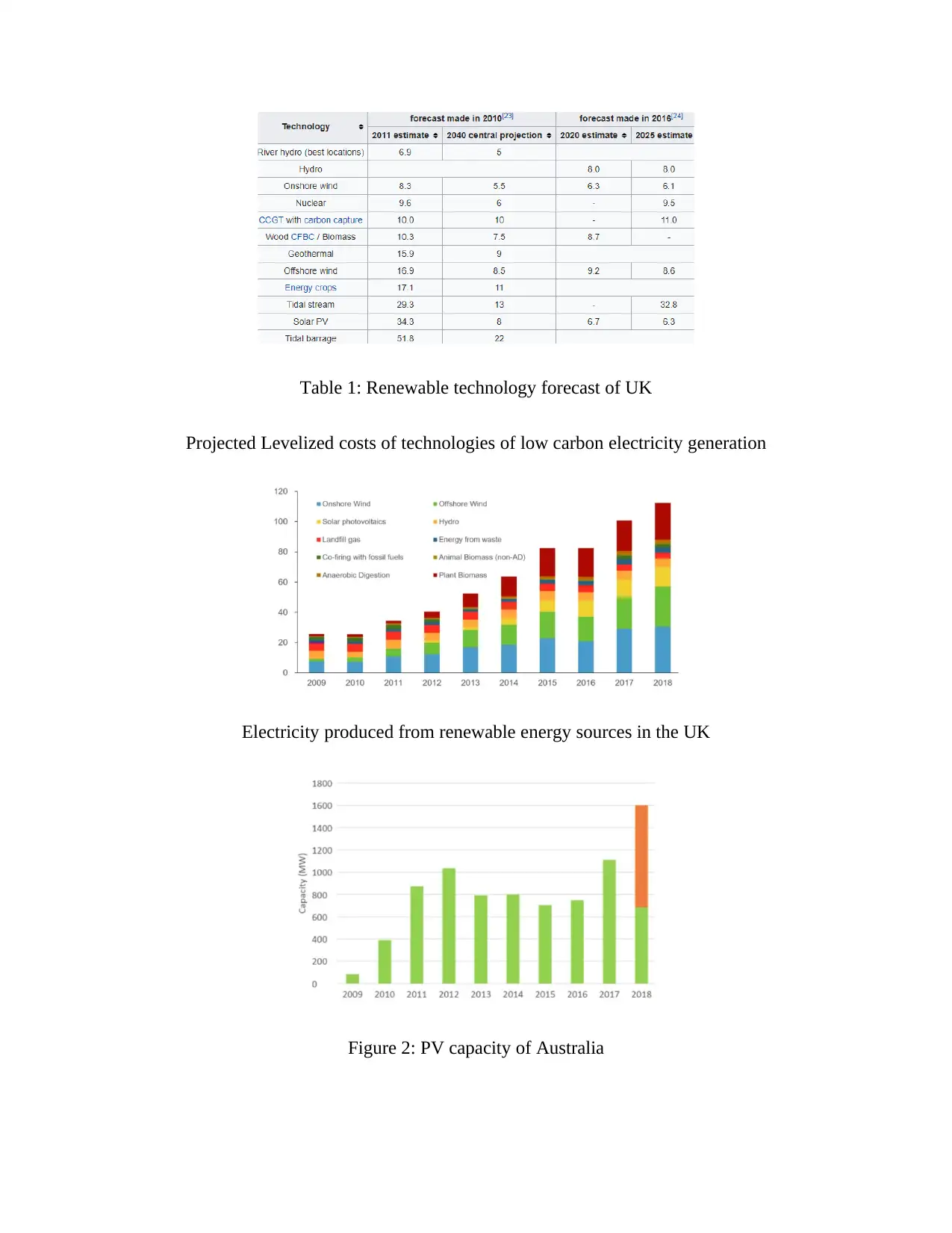
Table 1: Renewable technology forecast of UK
Projected Levelized costs of technologies of low carbon electricity generation
Electricity produced from renewable energy sources in the UK
Figure 2: PV capacity of Australia
Projected Levelized costs of technologies of low carbon electricity generation
Electricity produced from renewable energy sources in the UK
Figure 2: PV capacity of Australia
Paraphrase This Document
Need a fresh take? Get an instant paraphrase of this document with our AI Paraphraser
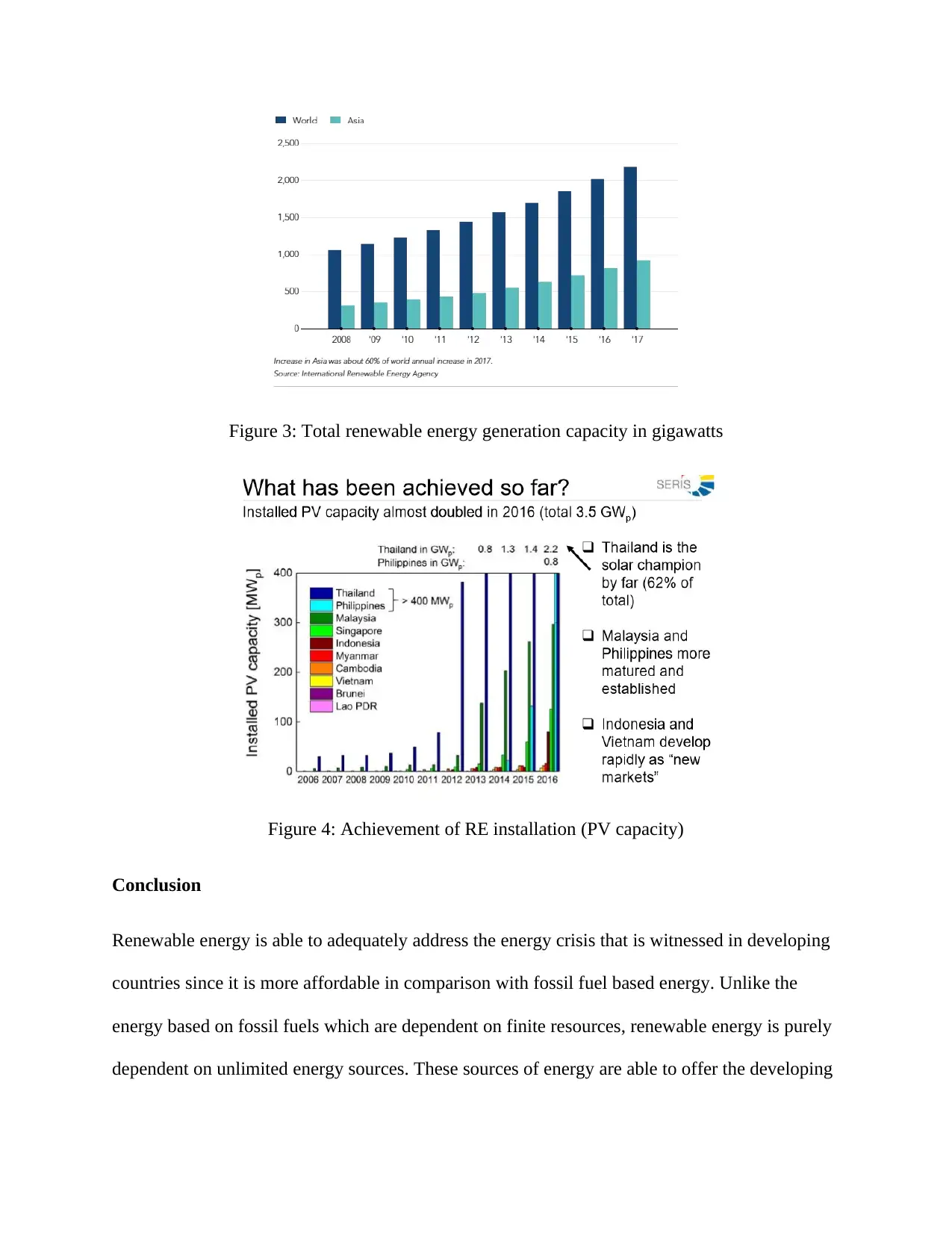
Figure 3: Total renewable energy generation capacity in gigawatts
Figure 4: Achievement of RE installation (PV capacity)
Conclusion
Renewable energy is able to adequately address the energy crisis that is witnessed in developing
countries since it is more affordable in comparison with fossil fuel based energy. Unlike the
energy based on fossil fuels which are dependent on finite resources, renewable energy is purely
dependent on unlimited energy sources. These sources of energy are able to offer the developing
Figure 4: Achievement of RE installation (PV capacity)
Conclusion
Renewable energy is able to adequately address the energy crisis that is witnessed in developing
countries since it is more affordable in comparison with fossil fuel based energy. Unlike the
energy based on fossil fuels which are dependent on finite resources, renewable energy is purely
dependent on unlimited energy sources. These sources of energy are able to offer the developing
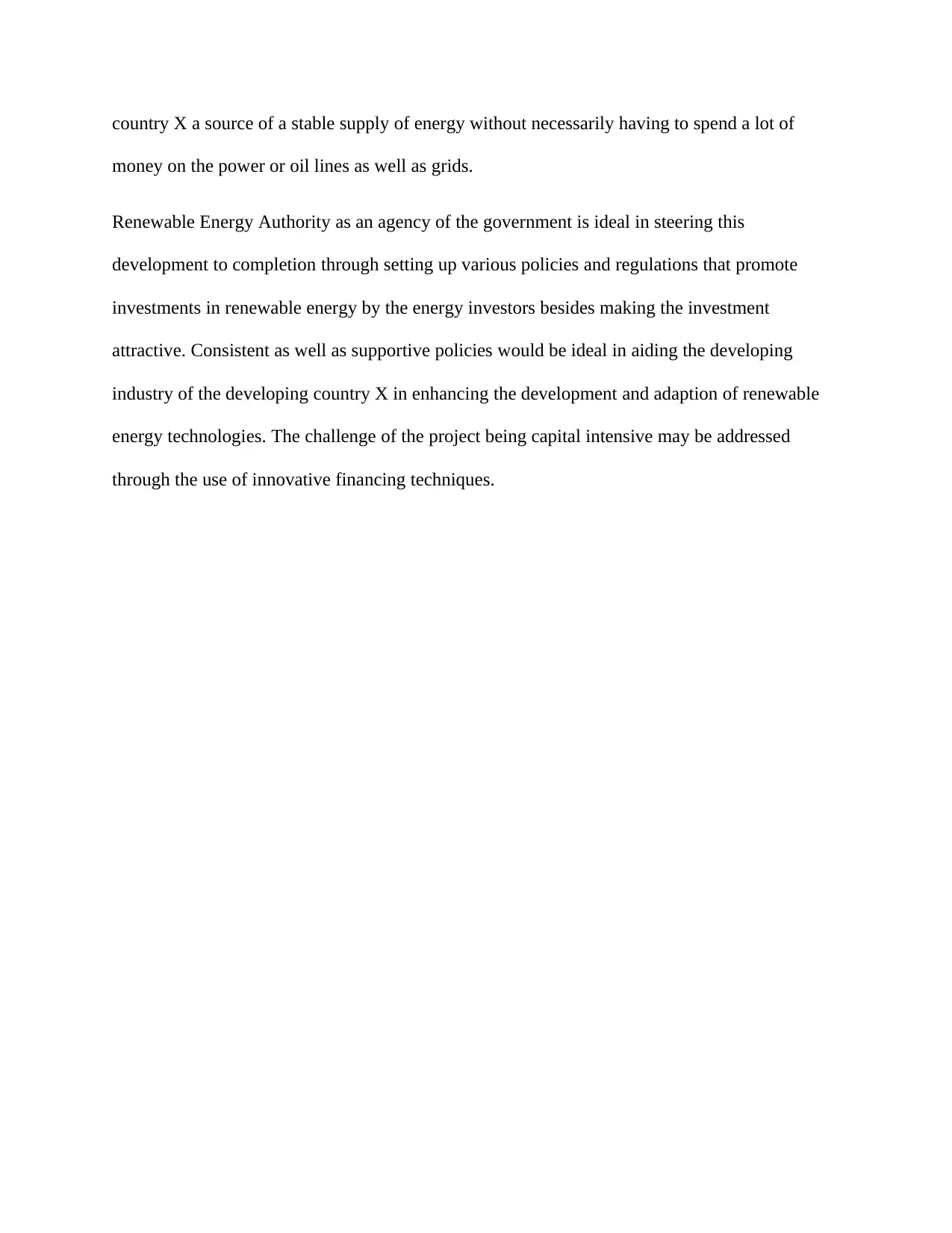
country X a source of a stable supply of energy without necessarily having to spend a lot of
money on the power or oil lines as well as grids.
Renewable Energy Authority as an agency of the government is ideal in steering this
development to completion through setting up various policies and regulations that promote
investments in renewable energy by the energy investors besides making the investment
attractive. Consistent as well as supportive policies would be ideal in aiding the developing
industry of the developing country X in enhancing the development and adaption of renewable
energy technologies. The challenge of the project being capital intensive may be addressed
through the use of innovative financing techniques.
money on the power or oil lines as well as grids.
Renewable Energy Authority as an agency of the government is ideal in steering this
development to completion through setting up various policies and regulations that promote
investments in renewable energy by the energy investors besides making the investment
attractive. Consistent as well as supportive policies would be ideal in aiding the developing
industry of the developing country X in enhancing the development and adaption of renewable
energy technologies. The challenge of the project being capital intensive may be addressed
through the use of innovative financing techniques.
⊘ This is a preview!⊘
Do you want full access?
Subscribe today to unlock all pages.

Trusted by 1+ million students worldwide
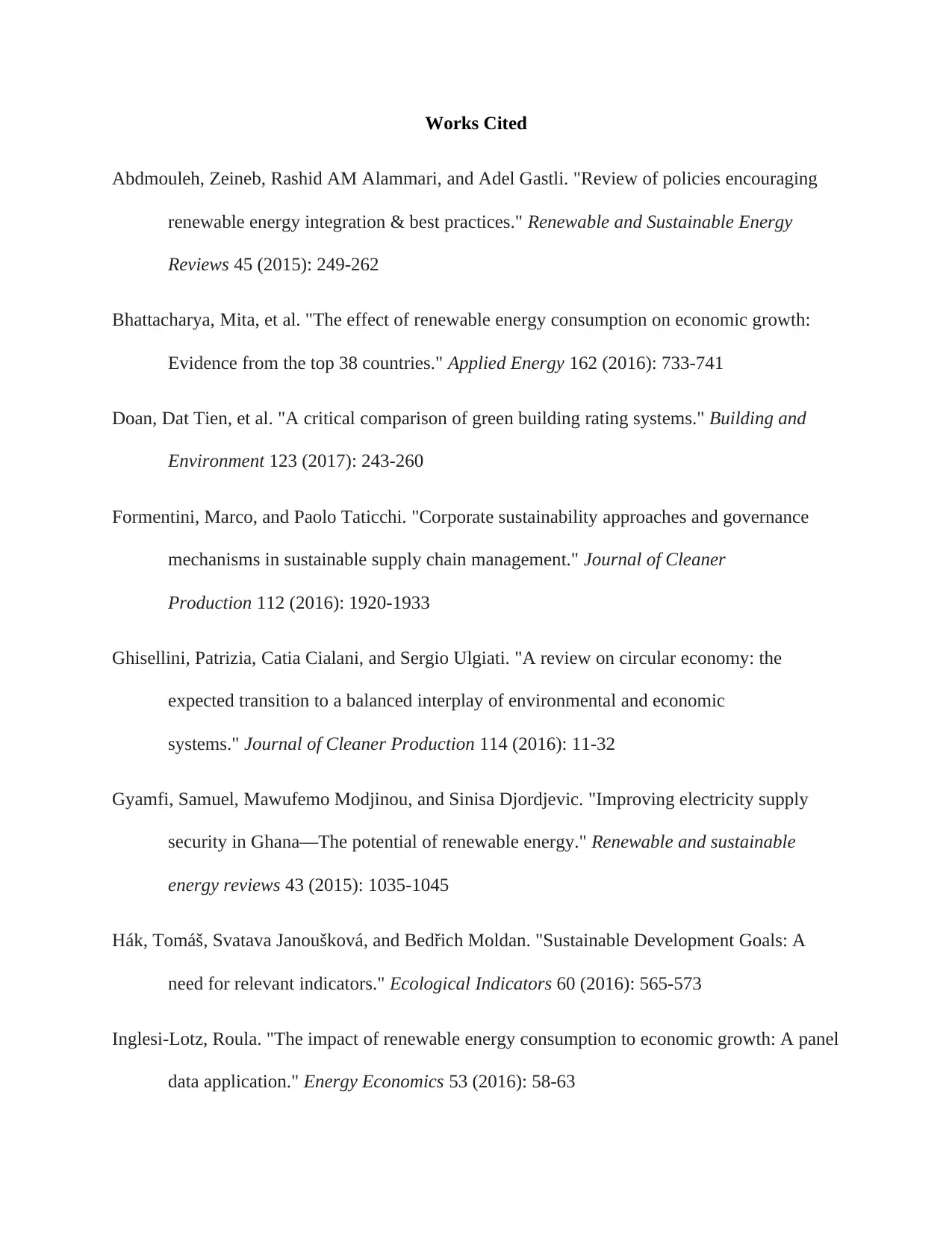
Works Cited
Abdmouleh, Zeineb, Rashid AM Alammari, and Adel Gastli. "Review of policies encouraging
renewable energy integration & best practices." Renewable and Sustainable Energy
Reviews 45 (2015): 249-262
Bhattacharya, Mita, et al. "The effect of renewable energy consumption on economic growth:
Evidence from the top 38 countries." Applied Energy 162 (2016): 733-741
Doan, Dat Tien, et al. "A critical comparison of green building rating systems." Building and
Environment 123 (2017): 243-260
Formentini, Marco, and Paolo Taticchi. "Corporate sustainability approaches and governance
mechanisms in sustainable supply chain management." Journal of Cleaner
Production 112 (2016): 1920-1933
Ghisellini, Patrizia, Catia Cialani, and Sergio Ulgiati. "A review on circular economy: the
expected transition to a balanced interplay of environmental and economic
systems." Journal of Cleaner Production 114 (2016): 11-32
Gyamfi, Samuel, Mawufemo Modjinou, and Sinisa Djordjevic. "Improving electricity supply
security in Ghana—The potential of renewable energy." Renewable and sustainable
energy reviews 43 (2015): 1035-1045
Hák, Tomáš, Svatava Janoušková, and Bedřich Moldan. "Sustainable Development Goals: A
need for relevant indicators." Ecological Indicators 60 (2016): 565-573
Inglesi-Lotz, Roula. "The impact of renewable energy consumption to economic growth: A panel
data application." Energy Economics 53 (2016): 58-63
Abdmouleh, Zeineb, Rashid AM Alammari, and Adel Gastli. "Review of policies encouraging
renewable energy integration & best practices." Renewable and Sustainable Energy
Reviews 45 (2015): 249-262
Bhattacharya, Mita, et al. "The effect of renewable energy consumption on economic growth:
Evidence from the top 38 countries." Applied Energy 162 (2016): 733-741
Doan, Dat Tien, et al. "A critical comparison of green building rating systems." Building and
Environment 123 (2017): 243-260
Formentini, Marco, and Paolo Taticchi. "Corporate sustainability approaches and governance
mechanisms in sustainable supply chain management." Journal of Cleaner
Production 112 (2016): 1920-1933
Ghisellini, Patrizia, Catia Cialani, and Sergio Ulgiati. "A review on circular economy: the
expected transition to a balanced interplay of environmental and economic
systems." Journal of Cleaner Production 114 (2016): 11-32
Gyamfi, Samuel, Mawufemo Modjinou, and Sinisa Djordjevic. "Improving electricity supply
security in Ghana—The potential of renewable energy." Renewable and sustainable
energy reviews 43 (2015): 1035-1045
Hák, Tomáš, Svatava Janoušková, and Bedřich Moldan. "Sustainable Development Goals: A
need for relevant indicators." Ecological Indicators 60 (2016): 565-573
Inglesi-Lotz, Roula. "The impact of renewable energy consumption to economic growth: A panel
data application." Energy Economics 53 (2016): 58-63
Paraphrase This Document
Need a fresh take? Get an instant paraphrase of this document with our AI Paraphraser
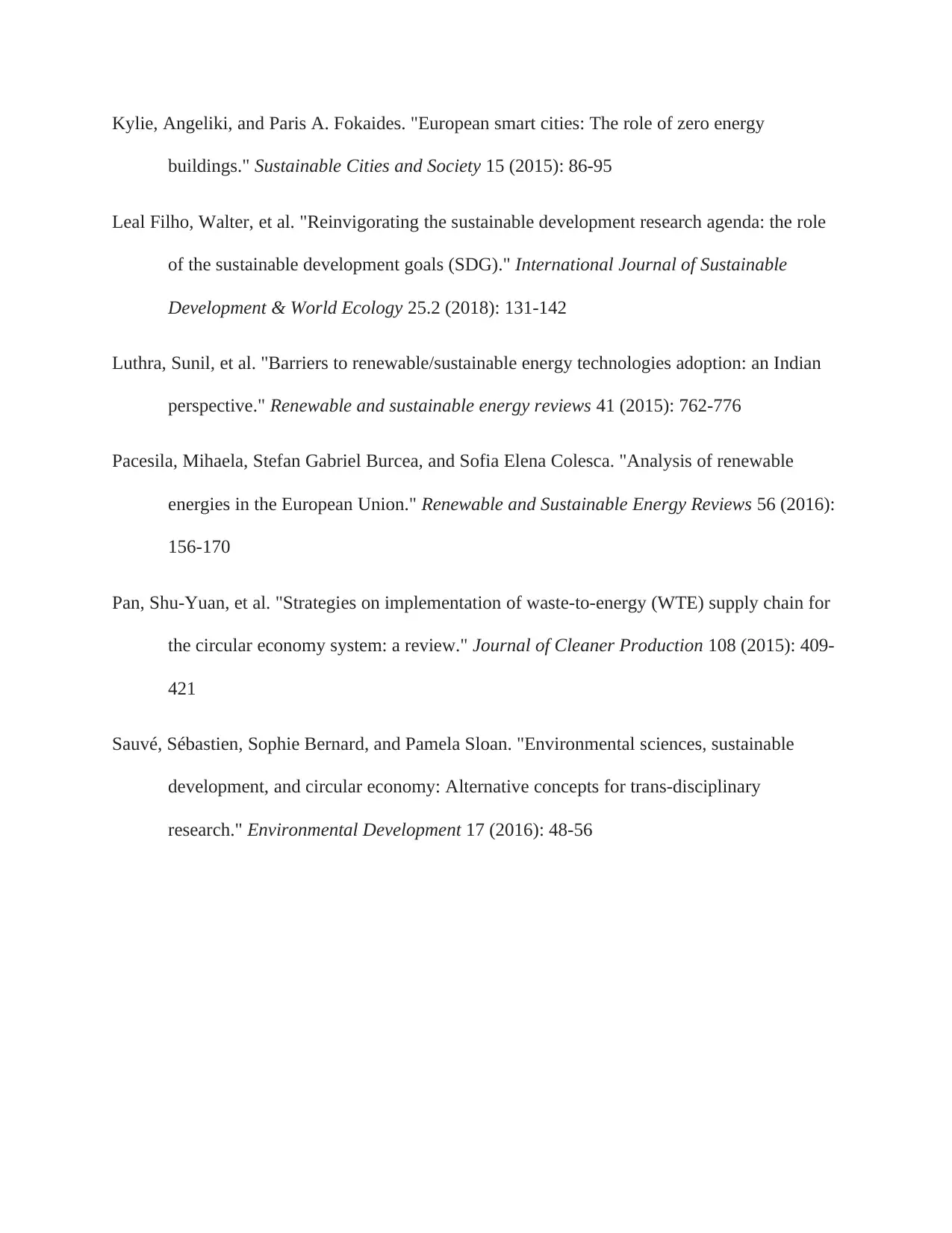
Kylie, Angeliki, and Paris A. Fokaides. "European smart cities: The role of zero energy
buildings." Sustainable Cities and Society 15 (2015): 86-95
Leal Filho, Walter, et al. "Reinvigorating the sustainable development research agenda: the role
of the sustainable development goals (SDG)." International Journal of Sustainable
Development & World Ecology 25.2 (2018): 131-142
Luthra, Sunil, et al. "Barriers to renewable/sustainable energy technologies adoption: an Indian
perspective." Renewable and sustainable energy reviews 41 (2015): 762-776
Pacesila, Mihaela, Stefan Gabriel Burcea, and Sofia Elena Colesca. "Analysis of renewable
energies in the European Union." Renewable and Sustainable Energy Reviews 56 (2016):
156-170
Pan, Shu-Yuan, et al. "Strategies on implementation of waste-to-energy (WTE) supply chain for
the circular economy system: a review." Journal of Cleaner Production 108 (2015): 409-
421
Sauvé, Sébastien, Sophie Bernard, and Pamela Sloan. "Environmental sciences, sustainable
development, and circular economy: Alternative concepts for trans-disciplinary
research." Environmental Development 17 (2016): 48-56
buildings." Sustainable Cities and Society 15 (2015): 86-95
Leal Filho, Walter, et al. "Reinvigorating the sustainable development research agenda: the role
of the sustainable development goals (SDG)." International Journal of Sustainable
Development & World Ecology 25.2 (2018): 131-142
Luthra, Sunil, et al. "Barriers to renewable/sustainable energy technologies adoption: an Indian
perspective." Renewable and sustainable energy reviews 41 (2015): 762-776
Pacesila, Mihaela, Stefan Gabriel Burcea, and Sofia Elena Colesca. "Analysis of renewable
energies in the European Union." Renewable and Sustainable Energy Reviews 56 (2016):
156-170
Pan, Shu-Yuan, et al. "Strategies on implementation of waste-to-energy (WTE) supply chain for
the circular economy system: a review." Journal of Cleaner Production 108 (2015): 409-
421
Sauvé, Sébastien, Sophie Bernard, and Pamela Sloan. "Environmental sciences, sustainable
development, and circular economy: Alternative concepts for trans-disciplinary
research." Environmental Development 17 (2016): 48-56
1 out of 11
Related Documents
Your All-in-One AI-Powered Toolkit for Academic Success.
+13062052269
info@desklib.com
Available 24*7 on WhatsApp / Email
![[object Object]](/_next/static/media/star-bottom.7253800d.svg)
Unlock your academic potential
Copyright © 2020–2025 A2Z Services. All Rights Reserved. Developed and managed by ZUCOL.





